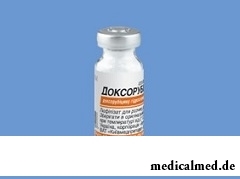





Doxorubicine
Application instruction:
 Doxorubicine – an anthracycline antineoplastic antibiotic with anti-proliferative and antimitotic action.
Doxorubicine – an anthracycline antineoplastic antibiotic with anti-proliferative and antimitotic action.
Form of release and structure
Dosage forms:
- Lyophilisate for preparation of solution for intravascular and intravesical introduction (on 10 ml in bottles, in a cardboard box of 10 pieces);
- Concentrate for preparation of solution for intravascular and intravesical introduction (on 5 ml in glass bottles, in a cardboard pack of 1 or 10 pieces; on 25 or 50 ml in glass bottles, in a cardboard pack of 1 piece).
Active agent – doxorubicine a hydrochloride:
- 1 bottle of lyophilisate – 10 mg;
- 1 ml of a concentrate – 2 mg.
Auxiliary component of lyophilisate – Mannitolum.
Indications to use
Use of Doxorubicine is shown at treatment of the following oncological diseases: an osteosarcoma, sarcoma of soft tissues, Ewing's sarcoma, Kaposha's sarcoma (patients have AIDS), a malignant thymoma, a retinoblastoma, a hepatoblastoma, a neuroblastoma, Vilms's tumor, trophoblastic tumors, carcinoid, an acute miyeloblastny leukosis, an acute lymphoblastoid leukosis, a chronic lymphoid leukosis, a nekhodzhkinsky lymphoma, a multiple myeloma, a lymphogranulomatosis, small-celled cancer of a lung, a breast cancer, cancer of a thyroid gland, gullet cancer, primary hepatocellular cancer, a carcinoma of the stomach, a pancreatic cancer, ovarian cancer, a germinogenny tumor of a small egg, endometrial cancer, a prostate cancer, cancer of a neck of uterus, cancer of adrenal glands, bladder cancer (including prevention of a recurrence after surgery).
Contraindications
- The expressed functional oppression of marrow against the background of use of radiation therapy and other chemotherapeutic means;
- Leukopenia;
- Acute hepatitis;
- Heavy abnormal liver functions;
- Thrombocytopenia;
- Serious illness of heart, including the expressed disturbances of a rhythm, myocarditis, an acute phase of a myocardial infarction;
- Anemia;
- The previous therapy in limit total doses anthracyclines;
- Period of pregnancy and breastfeeding;
- Hypersensitivity to hydroxybenzoates.
Besides, intravesical administration of drug is contraindicated to patients with invasive tumors with a penetration in a bladder wall, with infections and an inflammation of urinary tract and a bladder.
Route of administration and dosage
Lyophilisate is intended for intravesical, intravenous (in/in) or intra arterial (in / and) introductions.
Use of drug is shown both at monotherapy, and at a combination with other cytostatic means in the doses corresponding to the scheme of treatment.
The dose is appointed by the oncologist individually.
Lyophilisate of doxorubicine of a hydrochloride is recovered by water for injections or 0,9% chloride sodium solution just before use. A necessary single dose of the received solution in addition part in 0,9% chloride sodium solution in a proportion no more than 1 mg of drug on 1 ml.
At in appointment the received solution is entered into the port for system injections for in/in injections within 3-10 minutes during bystry infusion of 0,9% of solution of sodium of chloride or 5% of solution of a dextrose. Before introduction it is necessary to make sure that the needle (or a catheter) is established precisely in a vein. Administration of drug in veins over joints or in small veins is undesirable, it is impossible to enter into extremities with the lymphatic and venous outflow broken by a venipuncture.
The recommended dosing at in introduction:
- Monotherapy: on 1 cycle of therapy on 60-75 mg on 1 sq.m. of a body surface each three weeks, usually, cyclic dose is entered once, in need of it it is possible to divide into several doses, for example, on 25-30 mg on 1 sq.m. a day in the first 3 days of a cycle. For decrease in toxic action, especially cardiotoxicities of doxorubicine, administration of drug can be made weekly on 10-20 mg on 1 sq.m.;
- The combined treatment: doxorubicine a hydrochloride each 3-4 weeks appoint in a cyclic dose 30-60 mg to 1 sq.m. Each following administration of drug is possible only in the absence of toxicity signs, in particular hematologic and gastrointestinal.
The total dose of Doxorubicine should not exceed 550 mg on 1 sq.m.
The patients who was earlier applying other cardiotoxic means or receiving radiation therapy on pericardiac or area of a mediastinum, introduction of a total dose of doxorubicine need to carry out more than 450 mg on 1 sq.m. under strict monitoring of function of heart.
At patients with an abnormal liver function the dose of drug should be lowered according to the level of concentration of the general bilirubin in blood serum: at the level of bilirubin of 1,2-3 mg/dl, decrease is made for 50% of the recommended dose if exceeds 3 mg/dl – for 75%.
It is recommended to make increase in intervals between cycles or purpose of lower doses to the patients who earlier received extensive antineoplastic therapy, the patient with the obesity, tumoral infiltration of marrow sick of advanced and children's age.
Administration of Doxorubicine in a bladder is appointed at treatment of superficial tumors of a bladder and prevention of a recurrence after a transurethral resection. Intravesical introduction is not suitable for treatment of invasive tumors with a penetration in a muscular wall of a bladder.
The recommended dosing for intravesical introduction – on 30-50 mg on one installation, depending on the use purpose – treatment or prevention, a break between procedures can make from 1 week to 1 month. To provide uniform impact on all mucous surface of a bladder, after installation, the patient has to change every fifteen minutes position of a body from one side for another. Drug has to be in a bladder within 1-2 hours, then the patient has to empty it.
At emergence of symptoms of chemical cystitis (discomfort in a bladder, a dysuria, a nocturia, a polyuria, a hamaturia, an urodynia, a bladder wall necrosis) a dose it is necessary to dissolve 0,9% of solution of sodium of chloride in 50-100 ml. Special attention is recommended to be paid to catheterization problems, including at treatment of patients with the obstruction of an urethra caused by massive intravesical tumors.
Intra arterial introduction to the general hepatic artery is appointed to patients with hepatocellular cancer for the purpose of ensuring the strengthened local influence and simultaneous decrease in the general toxic load of an organism. Dosing makes on 30-150 mg on 1 sq.m. with a break from 3 weeks to 3 months. Use of higher doses is allowed only at a possibility of simultaneous extracorporal removal of drug.
Doxorubicine in the form of a concentrate is intended for in/in and intravesical introduction. The mode of dosing depends on a condition of the patient, clinical indications and the scheme of cytotoxic therapy.
Side effects
Use of Doxorubicine can cause side effects:
- From bodies of the digestive tract (DT): vomiting, nausea, an esophagitis or stomatitis (can appear in 5-10 days, most possibly after 3 consecutive days of introduction, and to cause development of heavy infections), an ulceration in a GIT; seldom – diarrhea, anorexia;
- From cardiovascular system and system of a hemopoiesis: less than at 10% of the patients who received the general total dose more than 550 mg on 1 sq.m. of a body – congestive heart failure, with manifestations in the form of an asthma, the speeded-up or spasmodic heartbeat, puffiness of anklebones and feet (pathology demands immediate drug withdrawal as there can be a development of an irreversible, lethal cardiomyopathy, the probability of its development after drug withdrawal depends on the received dose and the period of treatment); acute ventricular and atrial arrhythmia (as a rule, during the first hours after introduction); seldom (after use during from several days to several weeks) – toxic myocarditis or a syndrome of a pericardis myocarditis (heart failure, a pericardis, tachycardia); the leukopenia reaching peak by 10-15 day of treatment (the blood count is usually recovered for 21 days after completion of use of drug); thrombocytopenia; in case of very bystry introduction – a hyperemia on the course of a vein and rush of blood to the person; a phlebosclerosis (at introduction to small veins or several times in a row in one vein);
- From urinogenital system: a nephropathy, a hyperuricemia, urine discoloration (urine gets the reddish coloring disappearing within 48 hours); at intravesical introduction – burning in an urethra and a bladder, a zatrudnennost, morbidity and other frustration of an urination, a hamaturia, cystitis;
- Allergic reactions: an itch, skin rash, a fever, the increased body temperature, an anaphylaxis;
- From integuments: darkening of nails, palms and soles; development of a full and reversible alopecia; recurrence of a beam erythema;
- Others: cellulitis, extravasate, a necrosis (in case of hit in surrounding fabrics), it is rare – dacryagogue, conjunctivitis.
Special instructions
Doxorubicine cannot be mixed with other antineoplastic means in one syringe.
During treatment it is necessary regularly (at least 2 weekly) to control blood indicators, action of the heart and a liver as dozolimitiruyushchy factors are cardiotoxicity and oppression of a marrowy hemopoiesis. A course of repeated therapy can be conducted only at total absence of signs of a gematotoksichnost.
Patients with the previous cytotoxic or radiation therapy, the patient of advanced or children's age with an insufficient reserve of marrow should appoint drug with care.
Any dental interventions should be carried out prior to Doxorubicine use as their carrying out during treatment can increase risk of microbic infections, bleeding of gums and to promote delay of processes of healing.
Injection should be stopped immediately at hit of drug under skin and to continue an injection in other vein.
After chemotherapy drug should be used not earlier than in 1 month.
At increase in risk of development of a nephropathy against the background of growth of level of concentration of uric acid in blood serum it is necessary to carry out correction of doses of uricosuric antigouty drugs. In the course of therapy it is necessary to provide consumption of enough liquid and strengthening of a diuresis for removal of uric acid.
The procedure of use of drug has to be made with observance of the standard measures of sterility at preparation and dilution of injection solutions by specially trained medical personnel. After holding a procedure, the used syringes, needles, bottles, ampoules and the remains of unused drug are subject to utilization.
Medicinal interaction
Active ingredient of Doxorubicine has high activity therefore only the oncologist can consider his interaction with at the same time accepted drugs.
Terms and storage conditions
To protect from children.
To store in the place protected from light at a temperature: lyophilisate – is not above 5 °C, a concentrate – 2-8 °C, not to freeze.
Period of validity – 2 years.
The American scientists made experiments on mice and came to a conclusion that water-melon juice prevents development of atherosclerosis of vessels. One group of mice drank usual water, and the second – water-melon juice. As a result vessels of the second group were free from cholesteric plaques.

For many women the word "fat" sounds as a sentence. In aspiration to an ideal figure they try to exclude, first of all, from with...
Section: Articles about health
Tick-borne encephalitis – one of the most dangerous viral diseases which causative agents transfer and is given to people by ixodic mites. These are the small blood-sicking insects living in the considerable territory of our country. The person bitten by a tick can catch...
Section: Articles about health
Separate food - the system of meal based on digestion physiology which is carried to improvement methods. According to nutritionists, the separate use of the carbohydrate and proteinaceous products demanding different conditions of assimilation helps to get rid of diseases of digestive tract and serves as prophylactic from a diabetes mellitus, arthritis, food allergies, cholelithiasis and many other frustration. The essence of salutary effect of a method consists in most Kacha...
Section: Articles about health
80% of women at least once to lives complained of discomfortable feelings to breasts, consolidations and nagrubaniye. These are mastopathy symptoms. Mas...
Section: Articles about health
Partial and the more so full loss of hearing significantly reduces quality of life. Difficulties with communication lead to loneliness and isolation. The person who badly hears experiences difficulties with social and professional implementation, quite often has problems in...
Section: Articles about health
Childbirth is the most important event in life of each woman. We are women we give birth to the new little man on this light. Now the tendency to that was outlined, as men want to participate in labor too. But there is a question and whether it is worth allowing the husbands on childbirth?...
Section: Articles about health
The business lady, the become mother, it is necessary to solve an array of problems. But of them is main: how to combine the beloved child and work?...
Section: Slideshow
The metabolism at each person proceeds in own way. However between the speed of this process and disposal of excess weight after all all have a dependence. Unfortunately, the people inclined to try on itself numerous "miracle" diets, not always at...
Section: Articles about health
Women quite often suffer from complexes concerning the sizes of the bust. Strangely enough, not too modest, and excessively curvy shapes become the reason of sincere discomfort sometimes. Except psychological problems, the big bust sometimes creates also quite notable malfunctions with health: his owner can feel muscular dorsodynias, feeling of constant fatigue and difficulty of breath. Over time excess loading leads to development of diseases позвоночн...
Section: Articles about health
The saying "the rich do not know how the other half lives" is known to all. In a broad sense it is that we can not always understand the person, about...
Section: Articles about health
You heard that laughter prolongs life? Researchers did not manage to establish longevity direct link with sincere fun yet, but several facts confirming beneficial influence of risibility on the state of health are clinically proved....
Section: Articles about health
The naturopathy sometimes moves as the new direction of medicine, something like fashionable hobby, and there is nothing farther from the truth. This most ancient direction, the word "naturopathy" is translated as "treatment by the nature", and, no doubt, treatment by natural gifts was the first and only, available to the person in ancient times. Despite modern achievements of medicine, the naturopathy remains urgent and today, anyway the person - a part of the nature, and природн...
Section: Articles about health
Beauty shop – the place which is associated only with positive emotions: joy, pleasure, relaxation. One...
Section: Articles about health
Shops of household appliances offer us the huge choice of various devices for the house. Whether there are among this abundance devices which not only facilitate house work, but also help to keep health of the person? Of course, and we will tell about them today....
Section: Articles about health
On health of the person physicians know about salutary action of animals long ago. About 7 thousand years ago great Hippocrates recommended to the patients riding walks for strengthening of a nervous system and increase in vitality....
Section: Articles about health
Cellulitis - very widespread cosmetic shortcoming which arises approximately at 80% of women sooner or later. Emergence ег...
Section: Articles about health
Many of us, probably, noticed more than once that from intellectual loadings at some point the brain as though "overheats" and "assimilation" of information is strongly slowed down. Especially this problem urgent for persons of age becomes more senior than fifty years. "It is already bad with...
Section: Articles about health
The state of health of the person in many respects depends on chemical composition of biological liquids of an organism. Specialists consider that PH value of these solutions has to be in range of 7,35-7, 45. The deviation in the smaller party (so-called "acidulation") is fraught with development of many heavy illnesses, failures in work of immune system, decrease in working capacity and deterioration of life. To avoid serious fluctuations of acidity of internal liquids it is necessary to adhere разумног...
Section: Articles about health
So, you resolved to lose weight. And now you try to understand what to begin with: from exercise stresses or a diet? And how to make, h...
Section: Slideshow
Water with a lemon - idle time in preparation drink which supporters of a healthy lifestyle already managed to appreciate. Used in a warm look and on an empty stomach, it is one of the most useful prophylactics allowing to prevent tens з...
Section: Articles about health
Each person knows that fervescence is an illness sign. However too low temperature (hypothermia), especially also can demonstrate existence of diseases when it is observed long enough. Such state is dangerous that it, unlike fever, does not give a serious inconvenience: patients usually complain only of weakness, drowsiness, apathy. Sometimes the fever and a cryesthesia in extremities joins. Many people at similar symptoms...
Section: Articles about health
People know that thermal sources have salutary force long ago. Treatment by natural waters is one and...
Section: Articles about health
The sclera and mucous membrane of an eye are intensively supplied with blood vessels which problem - to saturate nervous tissues of body with nutrients and oxygen. In a normality vessels are almost not noticeable, however at their expansion (owing to истонч...
Section: Articles about health
The person, as well as all other beings living on our planet feels weather changing. It is the normal meteosensitivity which is not causing to healthy people of special troubles. Meteodependence, on the contrary, is the morbid condition which is characterized by an exacerbation of chronic illnesses at change of air temperature, differences of atmospheric pressure, wind strengthening, magnetic storms and other "surprises" on which the nature is so generous. The people suffering from meteodependence have to з...
Section: Articles about health
The stroke is one of the most widespread diseases of the person, annually in the world about 6 million cases эт are registered...
Section: Articles about health
All of us, unfortunately, should face flu nearly an every year. It would seem, so frequent disease has to be studied already up and down, and each person, at least once by it had (and the number of such people in our country aims at 100%), a dolzha...
Section: Articles about health
High temperature - a frequent symptom of such widespread diseases as a SARS, quinsy, pneumonia, etc. To reduce heat, having facilitated a condition of the patient, doctors recommend to accept antipyretics, however their use is not always possible. Too frequent use of these drugs can lead to allergic reactions, and also overdose, causing poisoning. It happens also that there are no antipyretics simply in the house. In these situations it is pertinent to use it...
Section: Articles about health
